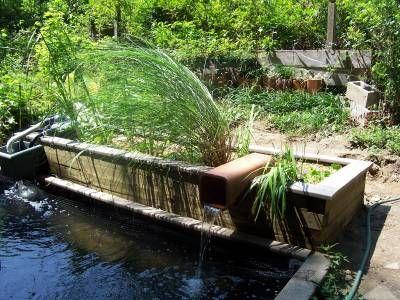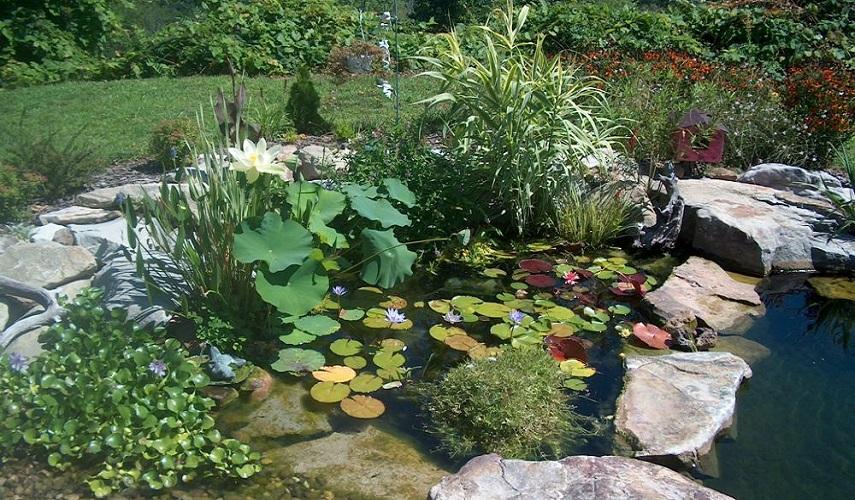Bog Filters: How to build a Bog Filter

You don’t need any specialist equipment to install this system. You just need a small area of your garden that can be turned into a small, shallow pond where you can plant the bog plants. Because it uses plants, you will want to show it off and make it the pride and joy of your garden.
What is a bog filter?
A bog filter consists of a small pond, usually a quarter of the size of the main pond that it is filtering. It is normally located next to the main pond, although can be used as a header pond for a stream; the main priority is to ensure that the water from the bog filter is connected to the main pond.
What are the benefits of a bog filter? (Useful Blogs: 5 Benefits of Pond Plants)
As bog filters are dominated by plants, the traditional benefits of plants apply to a bog filter. This means that your pond will have extra aeration, the plants will provide drama and they help to control algae. But this is all done by the plants being able to naturally filter the water for any pollutants (ammonia, nitrates, and nitrites) while providing a low maintenance filtration system. You also won’t need to clear any waste or pay any attention to the filtration system. The results are often cleaner, clearer, and healthier water with a beautiful, natural appearance which you may want to show off to friends and family.
Because bog filtration systems focus on having plenty of plants installed, this is a very environmentally friendly way of filtering your water and reducing your carbon footprint.
Further to the above, a whole range of plants can be used in this system; you don't need to stick to plants that are marketed as bog plants. For instance, our range of Oxygenator Plant Bundle, Ornamental Marginal Plant Bundle, and Wildlife Marginal Plant Bundle would be perfectly suitable for a bog filtration system. It is normally advised to avoid planting a lily in bog filters, given their shallow depths.
Principle behind bog filtration (Useful Blogs: Water Quality)
A bog filter is commonly described as a ‘natural wastewater management system’. It relies on plants to remove chemicals from your water before they can cause your pond to become toxic to wildlife and fish. Quite often, those who install a bog filter say their pond is clean, clear, and healthier for supporting life.
What makes bog filters different is that the plants are normally grown in a substate like pea gravel; this forces the plants to actively look for nutrients in the water rather than in the soil. However, plants in planting baskets can achieve a similar result.

As described above, a bog filter is a small, supplementary pond where you install a lot of plants. This means that the installation of a bog filter can be relatively easy. Simply install a pond (Please see our Pond Building Guide for help on this) and that is most of the job complete. Try to keep the depth of the bog filter pond to a maximum of 30cm (12 inches).
You will then need a pump in your pond capable of circulating your pond roughly every hour; this means if your pond has approximately 6,000 litres of water, you will need a pump that has a flow rate of 6,000 litres of water per hour (lph).
After installing the pump, you will need a length of hose that can be directed to your bog filter. Some of our customers purchase specialist ‘diffusers’ that can disperse the water throughout your bog filter. But it is relatively easy to make your own; simply purchase a long length of hose and drill holes every 5cm (2 inches). The hose can be configured into whatever pattern you want; though to prevent the need for Y-Pieces and connectors, most of our customers will lay the hose throughout the upper pond and curl it around the pond contours.
Once the hose is installed, try to cover the hose with pea gravel. Please note that if the pea gravel is smaller than the holes drilled into your hose, the pea gravel may cause blockages. Once the hose is covered, the plants can either be removed from their pots and placed on top of the pea gravel or placed into the pond in their baskets. If the plants are placed on top of the pea gravel, you should cover the plants up with extra pea gravel.
Once the pump is turned on, the water should flow from your main pond and up to the bog filter; the water will pass via the roots on the plants which will filter your pond. The water from this pond should then be directed back into your main pond.
Should I install a traditional filter with this system?
In most cases, you will not need a filter to keep your pond clean. However, combining the two different filtration systems will not harm your pond and should result in perfectly clean water with very little maintenance needed on the filter you purchase.
If you have any queries, please email us on info@pondkeeper.co.uk.